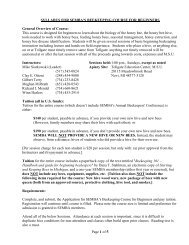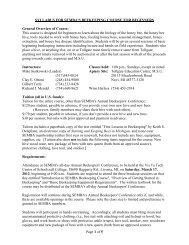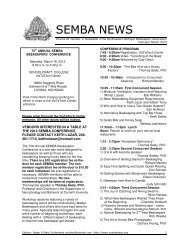SYLLABUS FOR SEMBA'S ADVANCED BEEKEEPING COURSE ...
SYLLABUS FOR SEMBA'S ADVANCED BEEKEEPING COURSE ...
SYLLABUS FOR SEMBA'S ADVANCED BEEKEEPING COURSE ...
Create successful ePaper yourself
Turn your PDF publications into a flip-book with our unique Google optimized e-Paper software.
<strong>SYLLABUS</strong> <strong>FOR</strong> <strong>SEMBA'S</strong><br />
<strong>ADVANCED</strong> <strong>BEEKEEPING</strong> <strong>COURSE</strong><br />
General Overview of Course:<br />
This course is designed for beekeepers with at least four (4) years of successful experience in<br />
beekeeping or who have satisfactorily completed SEMBA's Beekeeping Course for Beginners. It<br />
will be limited to no more than 30, and no less than 15, students. This course will consist of<br />
several sessions that will cover more advanced beekeeping topics such as alternative methods of<br />
raising queens, making splits and nuc's, maximizing honey production, etc. See the below page<br />
two for an overview of the course sessions and activities.<br />
Anticipated Instructors: Classes held: 10:00 a.m. - noon, Sundays, except as noted<br />
Winn Harless (Leader)<br />
Apiary Site: Tollgate Education Center<br />
(734) 453-2914 28115 Meadowbrook Road<br />
Bill Sirr (248) 544-8619 Novi, MI 48377-3128<br />
Clay E. Ottoni (248) 454-9800<br />
Don Schram (248) 310-8205 Rich Wieske (248) 705-5181<br />
Gilbert Terry (734) 233-8428 Roger Sutherland (734) 668-8568<br />
Paul Mazur (810) 686-9882 and/or other possible SEMBA Members<br />
Tuition (all in U.S. funds): Tuition for the entire course:<br />
$100 per student, payable in advance, if you are a current SEMBA member.<br />
$120 per student, payable in advance, if you are NOT a current SEMBA member.<br />
$30 per session; but only with prior approval and payment in advance.<br />
Tuition includes at least one queen cell. Tuition does not include any other bees, equipment,<br />
supplies, etc., nor does it include the following items required for the course: New wood ware,<br />
protective clothing, bee veil, hive tool, and smoker.<br />
Requirements:<br />
Either (a) satisfactory completion of SEMBA's Beekeeping Course for Beginners or (b) at least<br />
four (4) years of successful experience in beekeeping. At least one strong hive (preferably 3 or<br />
more hives) at your location and the legal right to add at least one additional hive (2 preferred).<br />
Equipment to make at least two (2) nucs (more recommended). Two (2) nuc boxes and your<br />
own queen-marking equipment. Cup with paper towels to move queen cell.<br />
Note the class size is limited to no more than 30, no less than 15, students.<br />
Students will participate in the training dressed in hive inspection attire (i.e., bee suit with<br />
attaching veil and helmet or hood, bee gloves, work boots or protective ankle wraps) and possess<br />
hive tool, smoker, and new woodware equipment. Attendance at each session is important, since<br />
it is difficult to duplicate hive conditions for non-attendees and classes build upon prior classes.<br />
Optional: Students that indicate an interest will have the option to join Winn Harless on a field<br />
trip to catch a swarm, conditions permitting (e.g., swarms being available as well as the<br />
availability of the interested student and Winn Harless).<br />
Page 1 of 4
<strong>ADVANCED</strong> <strong>BEEKEEPING</strong> <strong>SYLLABUS</strong><br />
OVERVIEW<br />
SESSION 1, MARCH 25<br />
• Introduction and setting goals -- raising queens, making splits and nuc's, over wintering hives<br />
and honey production.<br />
• Discuss honey maximizing strategies such as early spring build-up vs. equalizing hives.<br />
• Discuss tips to maximize honey production.<br />
• Discuss benefits of raising queens, banking queens, and two-queen systems.<br />
• Discuss desired breeding traits and outstanding genes.<br />
• Discuss conditions required for successful queen rearing.<br />
• Discuss quick queen introduction.<br />
• Discuss going medication free/the problems with our bees.<br />
• Discuss benefits of nucs.<br />
• Discuss different kinds of nucs.<br />
• Discuss making nucs.<br />
• Discuss required woodware, supplies and equipment.<br />
• TO DO: Identify future nuc placement, at your location.<br />
• TO DO: Begin building 5 Frame nuc(s), at your location.<br />
• TO DO: Begin building Cloak board, at your location.<br />
• TO DO: Begin building queen marking cage, at your location.<br />
SESSION 2, APRIL 29<br />
• Discuss tips to maximize honey production.<br />
• Discuss queen excluders not just for finding your queen.<br />
• Discuss queen location tips.<br />
• Discuss marking queens (using the international color code) and clipping queens.<br />
• Discuss benefits of splits.<br />
• Discuss bee math and making splits.<br />
• Discuss Cloake boarding, grafting larvae and cell punch.<br />
• Discuss importance of, and methods of, producing drones.<br />
• Discuss flying drones and mating areas.<br />
• Discuss swarm catching.<br />
• Discuss taking bees out of walls.<br />
• TO DO: Bring hive inspection attire.<br />
• TO DO: Inspect overwintered hives to determine best hive for breeding.<br />
• TO DO: Select hive within which to raise queens.<br />
• TO DO: Select 2 hives to produce drones.<br />
• TO DO: Install Cloake board FRAME (with a reducer for same) above lowest box in queen cell<br />
producing hive.<br />
• TO DO: Install a drone cell frame each of the two (2) drone mother hives.<br />
MAY 27, SUNDAY (optional, done at your location) Will be done at Tollgate, student<br />
attendance not required.<br />
(Optional) • TO DO: Install queen excluders between each box to aid in finding queen (both<br />
Cloake board and egg supply hives).<br />
Page 2 of 4
MAY 31, THURSDAY at 6:00 p.m. (done at your location) Will be done at Tollgate, student<br />
attendance not required.<br />
• TO DO: Be sure to have, else install, open drawn out wax foundation frames in brood area of<br />
other hive(s) from which to pull frames to cut out cell punches. Wise to confine<br />
queen in egg supply hives in box with all wax foundation frames for cell punching<br />
and/or black plastic for grafting. (Do not marker her, at this time.)<br />
• TO DO: Find queen and place her in lowest box (1 deep or two mediums) and place queen<br />
excluder over lowest box(es), turn bottom board and lowest box(es) around 180<br />
degrees (so the old front is now facing the old back), completely close the lowest<br />
entrance, place the Cloake board FRAME over the queen excluder with the<br />
opening facing the original front without the reducer for same, install remaining<br />
broad boxes over Cloake board FRAME as well as inner and outer covers.<br />
JUNE 2, SATURDAY at 10:00 a.m. (done at your location) Will be done at Tollgate, student<br />
attendance not required.<br />
• TO DO: Install Cloake board, wedge Cloake board open with three wedges, and open lowest<br />
entrance.<br />
SESSION 3, JUNE 3<br />
• Discuss tips to maximize honey production.<br />
• TO DO: Inspect hive (have 2 nuc boxes one each for pulled frames of broad on wax and black<br />
plastic frames).<br />
• TO DO: Confirm existence of flying drones.<br />
• Discuss grafting.<br />
• TO DO: Graft frame.<br />
• Discuss cell punch.<br />
• TO DO: Cell punch -- using small double boiler to melt wax, keep cutter in hot water, wax<br />
wood piece to bar, place bar in frame, find 1 day old larva (eggs straight-up, larva<br />
slight curve and on bottom), cut out, and wax to wood piece on bar.<br />
JUNE 4, MONDAY at 10:00 a.m. (done at your location) Will be done at Tollgate, student<br />
attendance not required.<br />
• TO DO: Remove Cloake board separator and wedges.<br />
SESSION 4, JUNE 12, TUESDAY 6:00 p.m. (done at Tollgate and, once you have your<br />
queen cell, at your location).<br />
• TO DO: Bring hive inspection attire.<br />
• TO DO: Bring equipment to safely transport queen cell.<br />
• TO DO: Pull queen cells and make nucs.<br />
• TO DO: Rearrange Cloake board hive to original hive configuration without Cloake broad.<br />
• TO DO: Take home queen cell.<br />
• TO DO: Make nuc at your location.<br />
JUNE 28, THURSDAY 6:00 p.m. (done at your location) Will be done at Tollgate, student<br />
attendance not required.<br />
• TO DO: Check for laying queen at your location.<br />
Page 3 of 4
SESSION 5, JULY 15<br />
• Discuss tips to maximize honey production.<br />
• Discuss shook swarm method.<br />
• Discuss propolis<br />
• Discuss small hive beetle, avoidance strategies and treatment options.<br />
• Discuss other bee pests and diseases A to Z with treatment/medication options.<br />
• Discuss Integrated Pest Management ("IPM").<br />
• Discuss what was done to the hive and nucs, and what we found.<br />
• TO DO: Bring hive inspection attire.<br />
• TO DO: Inspect nuc for laying queen.<br />
• TO DO: Inspect hives for Small Hive Beetle, other pests and diseases.<br />
• TO DO: Prepare marking queen by practicing on drones.<br />
SESSION 6, AUGUST 26<br />
• Discuss tips to maximize honey production.<br />
• Discuss rendering wax.<br />
• Discuss introducing a queen to your hive and to a laying worker hive.<br />
• Discuss Small Scale Pollination -- Taking Bees to Florida.<br />
• Discuss basic mead making.<br />
SESSION 7, SEPTEMBER 23<br />
• Discuss tips to maximize honey production.<br />
• Discuss Langstroth alternatives such as top bar hives, Warre hives and skeps.<br />
• Discuss small cell alternative.<br />
• Discuss overwintering nucs.<br />
• Discuss overwintering hives.<br />
• Discuss The Many Uses of Imirie Shims.<br />
• Discuss making of specialty and more advanced equipment.<br />
• Discuss applying your knowledge such as mentoring, teaching classes, becoming part of a<br />
board, helping to organize a bee club or conference, etc.<br />
• TO DO: Bring hive inspection attire.<br />
• TO DO: Inspect nucs.<br />
• TO DO: IPM, monitor hives for pests such as varroa mites and SHB.<br />
Page 4 of 4





